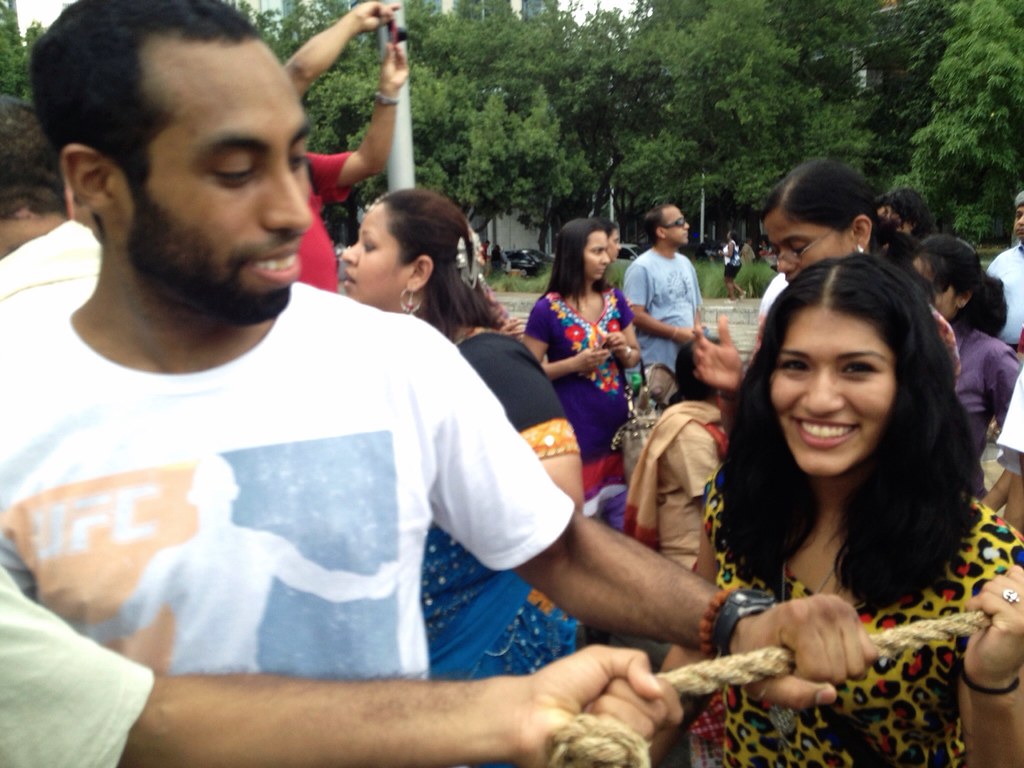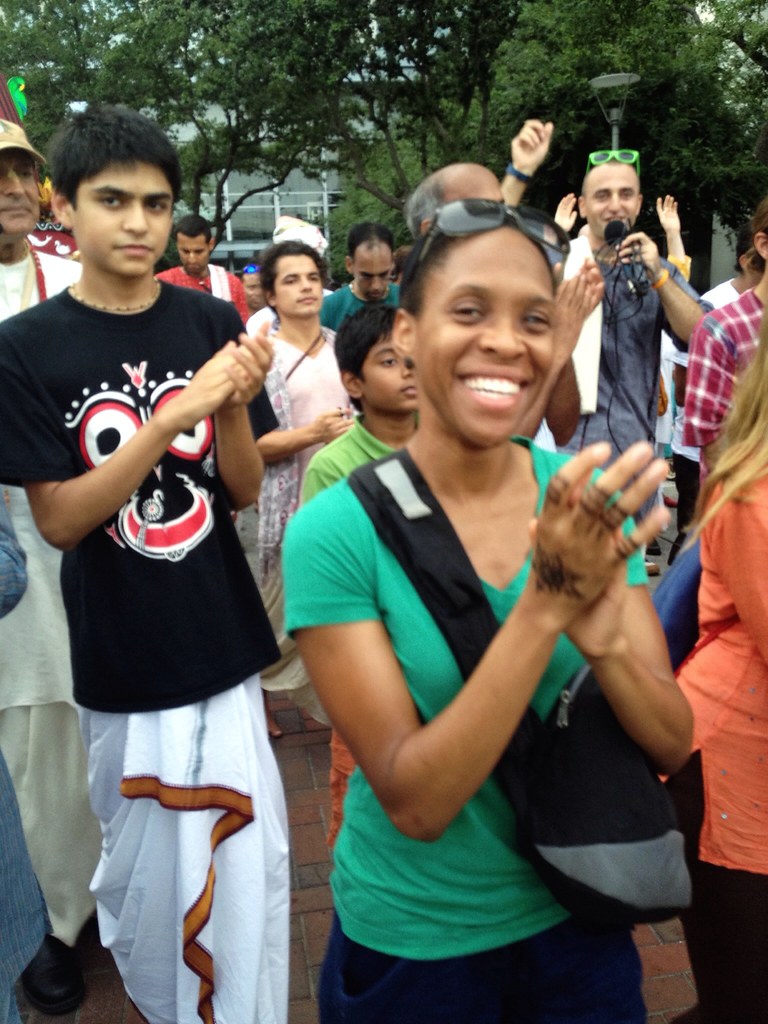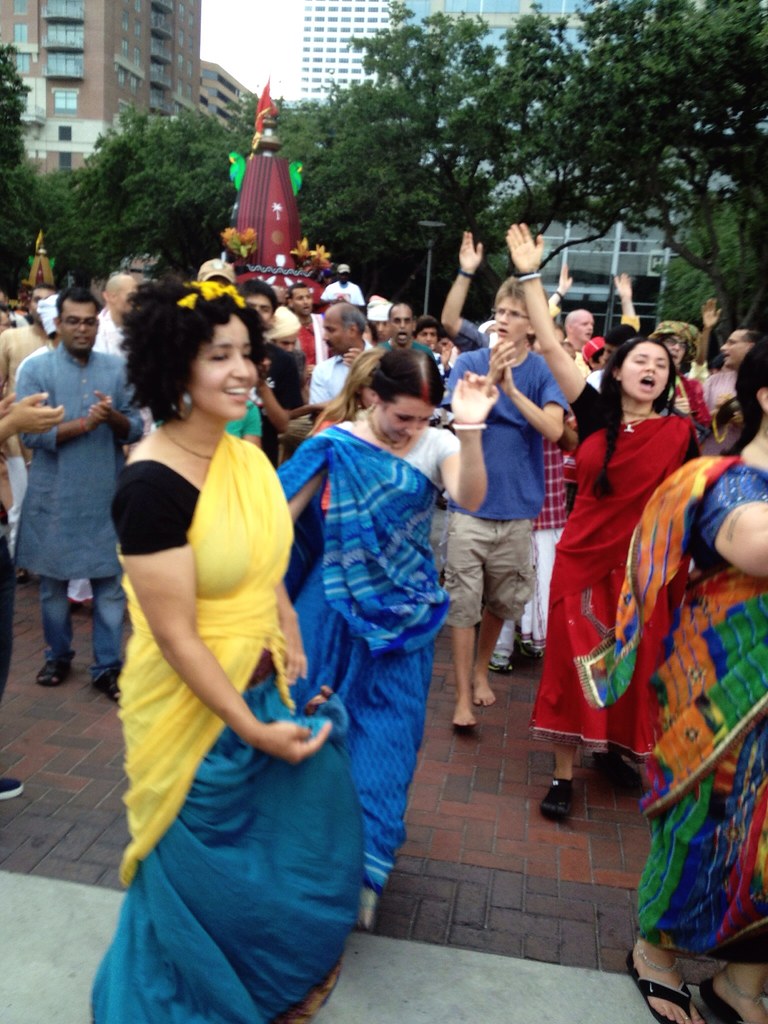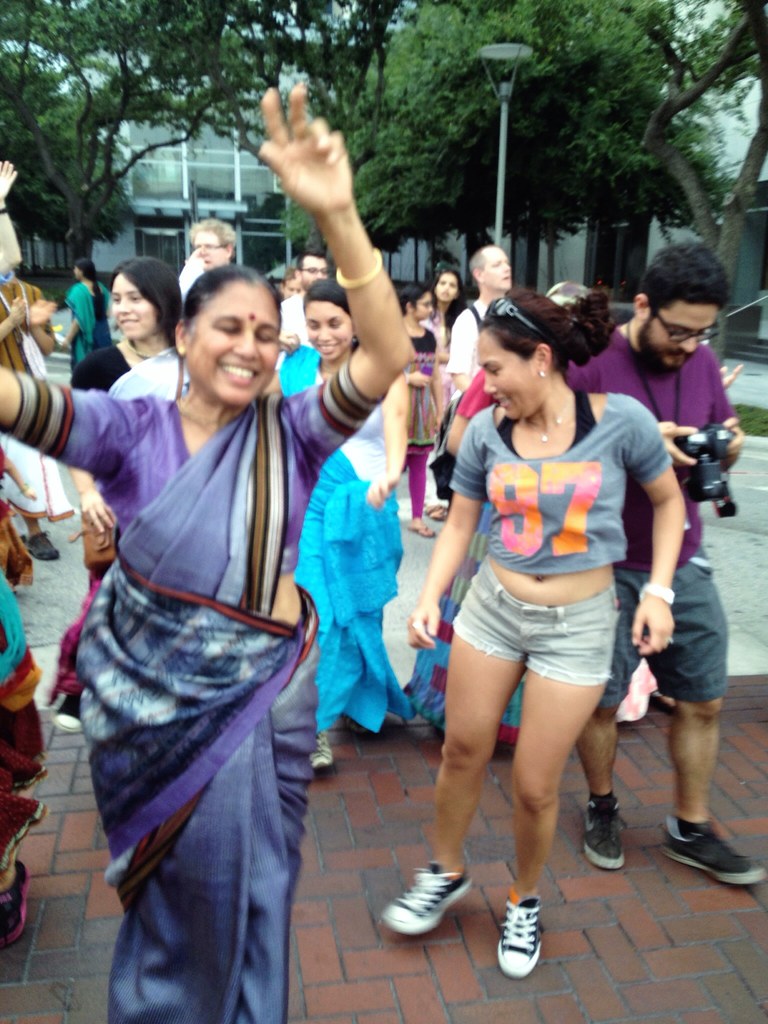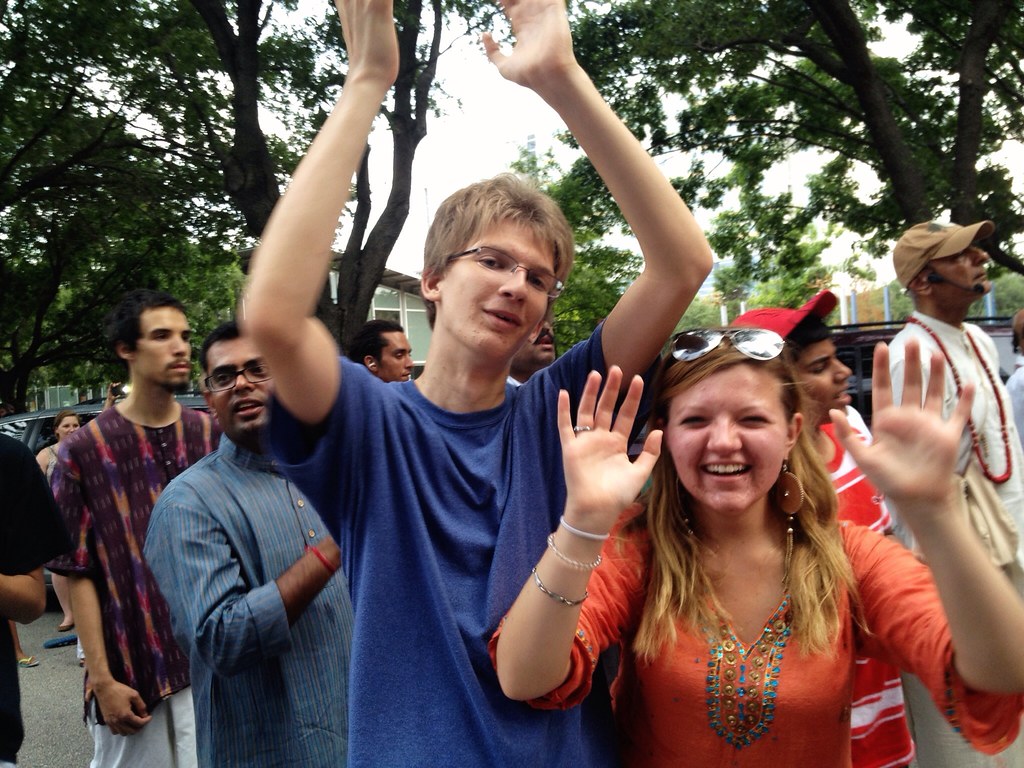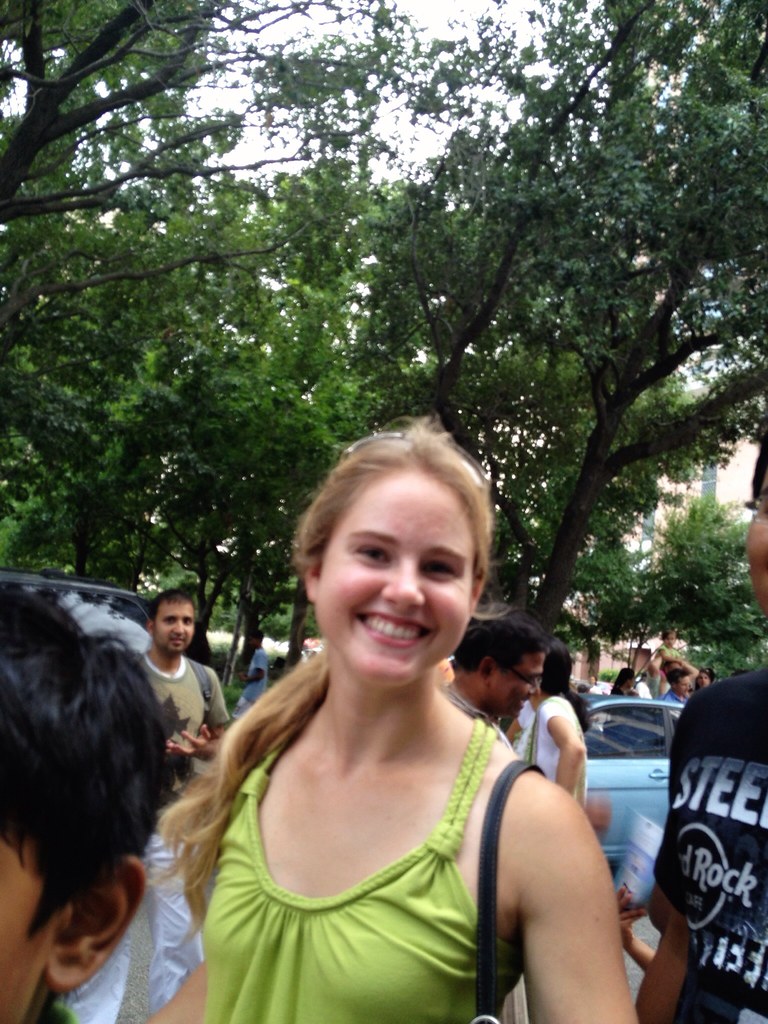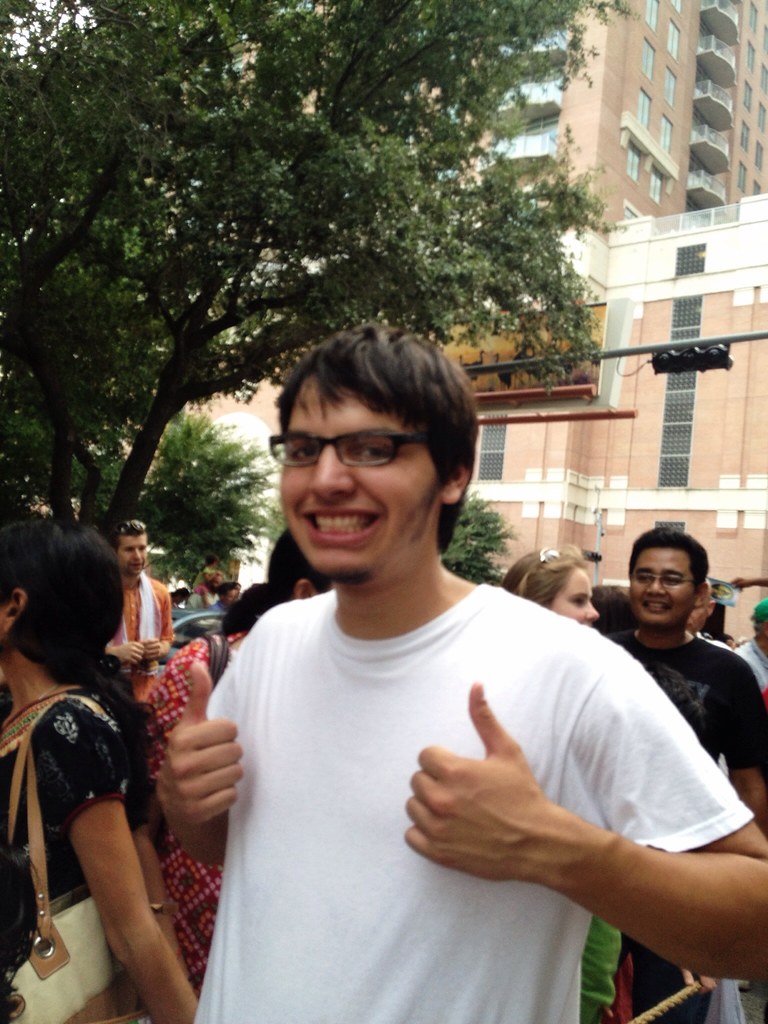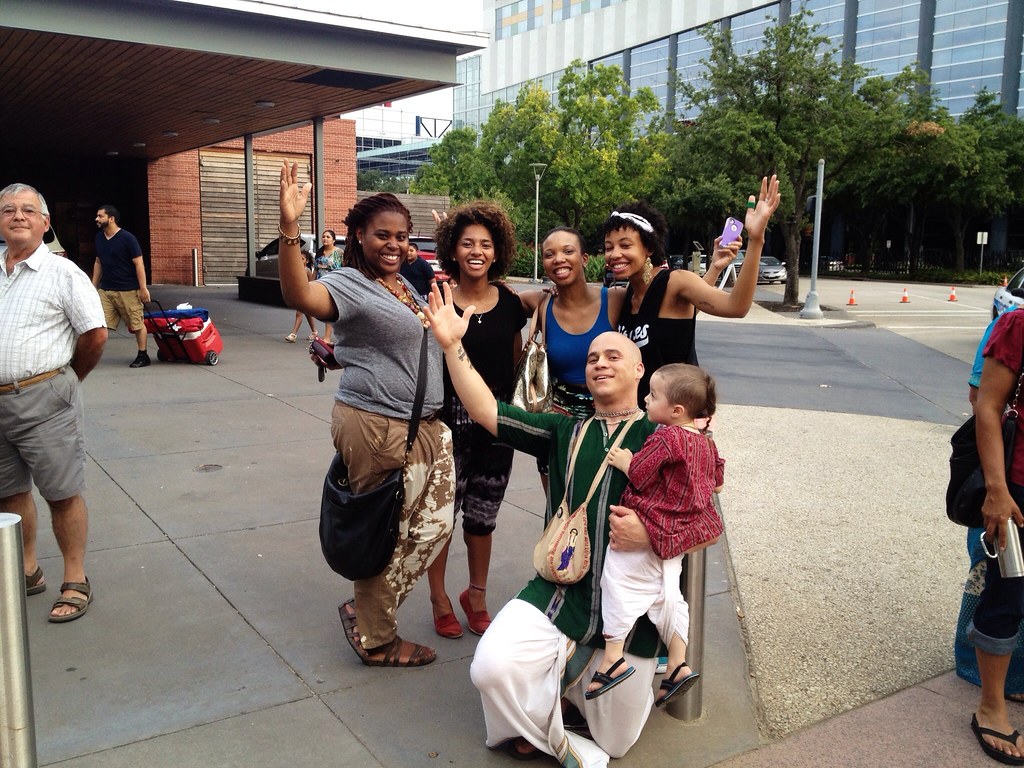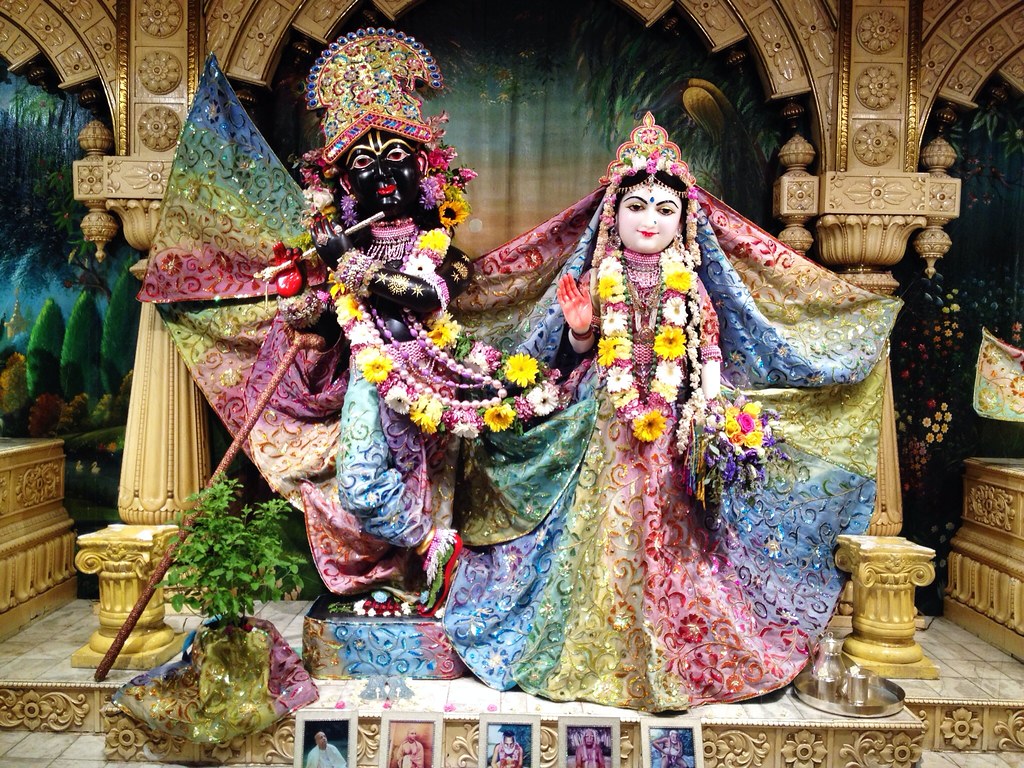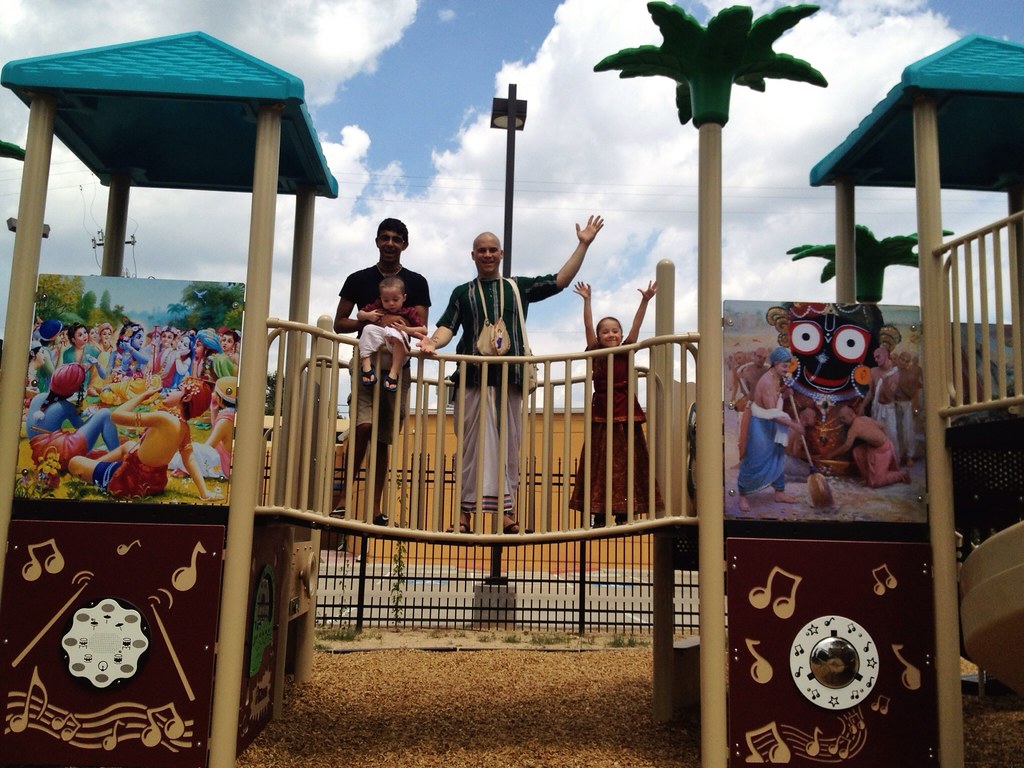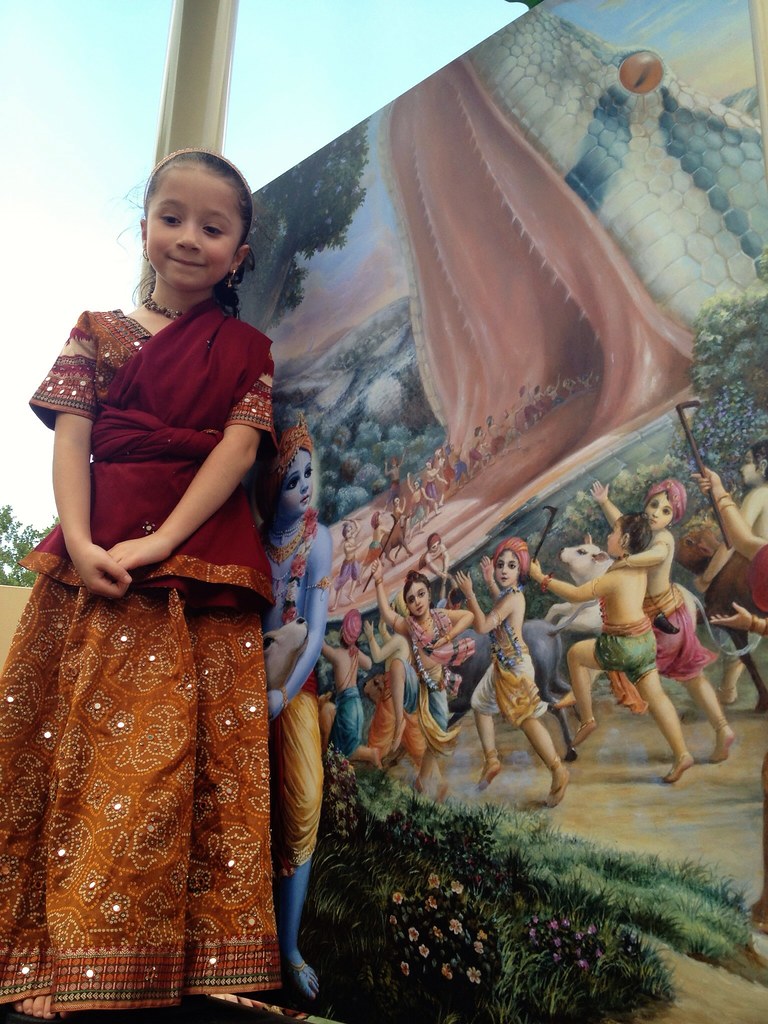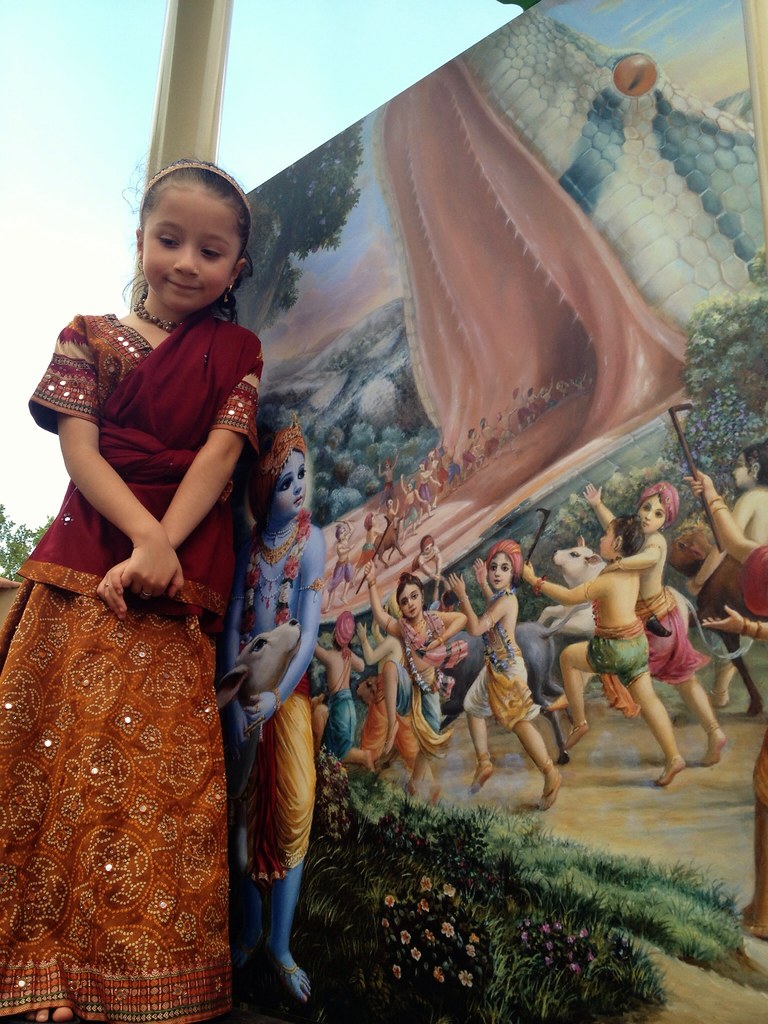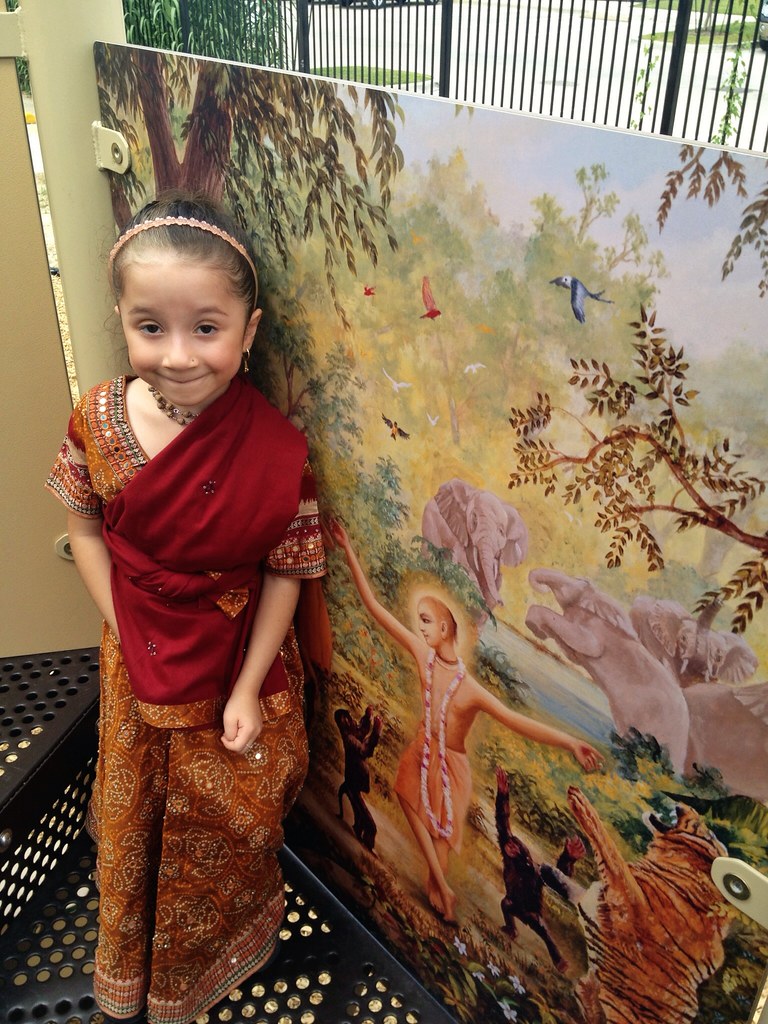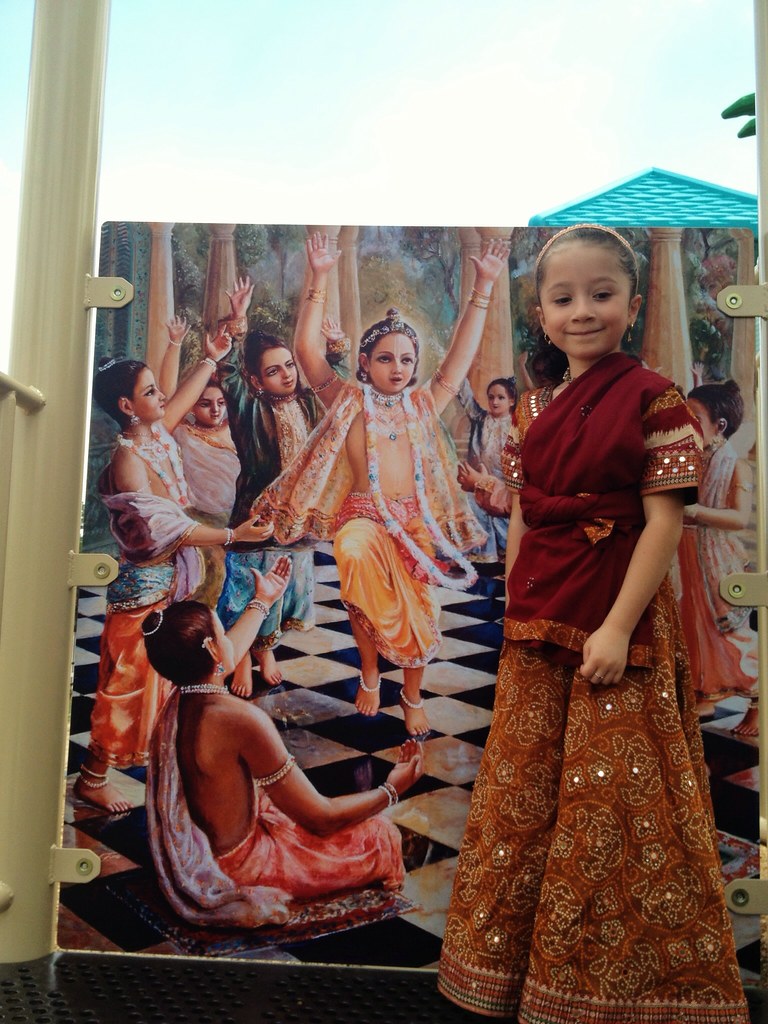The post July 15th, 2013 – Darshan appeared first on Mayapur.com.
July 15th, 2013 – Darshan
Down With Affluenza? ECOV’s Got the Cure
→ New Vrindaban Brijabasi Spirit
Down With Affluenza? ECOV’s Got the Cure.
by Madhava Smullen
Contrary to what advertisers would have us believe, stuff doesn’t make us happy. In fact, it could be just the opposite.
According to a study of Commerce Department data cited in the Wall Street Journal, U.S. consumers are set to spend $1.2 trillion in 2011 on non-essential goods including pleasure boats, jewelry, booze, gambling and candy. Yet 121 million people around the world, and 18 million in the U.S., suffer from depression, and suicide rates have increased by 60% worldwide in the last forty-five years.
Meanwhile, we are polluting the planet, causing climate change and loss of biodiversity, and leaving our children a toxic legacy. And despite our addiction to spending, even the economy is collapsing.
So what’s the alternative? Members of ECOV (Earth, Cows, Opportunity, and Villages), a cow protection organization set in the ISKCON Community of New Vrindaban, West Virginia, believe they have an effective one. It’s an agrarian lifestyle in harmony with nature, animals and the earth, that focuses on simple living and high thinking.
This approach is based on the Vedic culture of ancient India—in which the cow and bull were the very backbone of society, and treated as part of the family. In fact, the cow was deeply respected as the mother of mankind, and the bull as its father. For just as a child is fed with its mother’s milk, the cow feeds human society her milk; and just as the father earns for his children, the bull tills the ground to produce food grains.
These ideas were exemplified in India, yet practiced all over the world to some degree until modern times. Even in the U.S., as recently as the 1950s, a person’s flock and grains was his life.
ECOV Adviser Varshana Swami, who has dedicated much of his life to the pursuit of simple living and high thinking, recalls the exact time in his childhood when it all went wrong.
“As a kid in the late 1950s, I used to visit my grandfather’s farm in New York State regularly,” he says. “It was in such a backwoods town that the tractor hadn’t completely taken over yet, and they were still using animal power for agriculture. Then the tractor came to the village. First, it killed the social life by replacing all the villagers who would come together for the planting and the harvest. Then, its presence caused overproduction to the point that the government stepped in and started paying the farmers to stop growing crops. It literally put an end to agriculture.”
Of course, the tractor can have its uses and Varshana Swami doesn’t think it needs to be completely prohibited—as long as it doesn’t replace the ox. However for him, the tractor’s arrival is a symbol for modern humanity’s consumer addiction, which destroys the natural prosperity and spiritual advancement that past generations enjoyed.
Searching for a word to describe this affliction, he came across the term ‘affluenza’ in the dictionary. Its definition? “Extreme materialism which is the impetus for accumulating wealth and for over consumption of goods; also, feelings of guilt and isolation from the dysfunctional pursuit of wealth and goods.” The dictionary even adds that “its antidote is simple living.”
“Affluenza creates an unsustainable addiction to economic growth and plundering, which upsets the natural order of things,” explains Varshana Swami. “Let’s continue to use the tractor as an example. It’s born by plundering economies for iron ore, which is smelted in factories that pollute the environment. Then forests of sandalwood trees, which are traditionally used for sacrifices, are annihilated to plant rubber trees for the tires. Next, you need petroleum, the life blood of the earth, which spews polluting hydrocarbons into the atmosphere. Finally, the tractor is used to spread chemical fertilizers, which are made from the same ingredients as explosives, and which kill the soil.”
These fertilizers create vegetables and fruit that look big and lush, but lack taste and nutritional value. What to speak of so-called ‘organic fertilizer’—blood meal and bone meal made of crushed bones and blood from cow slaughterhouses that render even our ‘certified organic’ foods non-vegetarian.
Thus under the influence of affluenza and petroleum dependency, we kill our mother the cow and eliminate our father the ox from his place in the field. “If the father of society is unemployed, how can there be any question of prosperity in the family?” says Varshana Swami. “And so our modern disease of affluenza promises wealth but brings scarcity, exploitation, and plundering of the earth’s very life support systems.”
This is in stark contrast to the ancient system of agriculture—working with the cow, the ox, and the land in a simple way that fosters community, loving relationships, learning skills, and spiritual introspection. This natural order is a synergistic system of bounty, prosperity, and devotion.
“My guru, Srila Prabhupada, who encouraged his followers to establish farm communities based on these principles, defined true wealth as cows, land and grains,” Varshana Swami says. “And in ancient Vedic culture, the cow represents the earth, who in turn is also considered our revered mother. In fact, the ancient text Srimad-Bhagavatam explains that the earth is God’s consort, and an expansion of Radharani, the female aspect of Divinity.” On a practical level, the cow produces milk, the miracle substance which, the Srimad-Bhagavatam explains, is not only vastly versatile and nutritious but also the only food which develops the finer tissues of the human brain, enabling one to understand the subtleties of spiritual dynamics, relationships and truth.
Meanwhile the ox is an even more valuable creature. In Vedic culture, he represents Dharma, or the natural order of things, and since he pulls the plow, he is also the symbol for agriculture. Both his and the cow’s urine has medicinal and insecticidal properties, while their dung is the only way Varshana Swami knows of to revive soils which have been killed by chemical fertilizers.
Yet the prime reason why protecting the ox is more relevant now than ever before, is that as the tiller of the soil he’s our alternative to chemical and petroleum dependency—the lubricant that oils the consumer machine, and facilitates our addiction to non-essential stuff and our aversion to the simple life that will actually make us happy and content.
“The fragile industrial systems we’ve created for ourselves are going to fail,” concludes Varshana Swami. “We don’t know if it’s going to be sooner or later, sudden or gradual—but they are unsustainable, unnatural, and they will fail. That’s why I see reinstating the ox in his rightful position in our society as an extremely urgent mission.”
ECOV invites all to help it with this mission, either by supporting it financially or by lending help in working the land and taking care of its herd of cows and oxen. Experiencing this simple life is the only way to cure ourselves of affluenza and find true happiness—despite what advertisers would prefer us to believe.
Mission Statement: ECOV (Earth, Cows, Opportunities & Villages) is dedicated to cow protection, sustainable agriculture, self-sufficiency and simple living — all centered around loving service to Sri Krishna, as envisioned by the ISKCON New Vrindaban Founder-Acharya, His Divine Grace A.C. Bhaktivedanta Swami Prabhupada.
For more info, visit ECOV’s website.
For regular updates, we also invite you to “like” ECOV’s Facebook page.
Kirtan Mela Germany 2012 HG Radha Londonisvara Prabhu Day 2
→ Gouranga TV - The Hare Krishna video collection
Kirtan Mela Germany 2012 HG Radha Londonisvara Prabhu Day 2
Janmastami FOLK News Online Edition
→ ISKCON Melbourne, AU
 In this issue we feature the major festivals of August and September and stories that expand their glories: Mahanidhi Swami describes the elixir of Srimati Radharanis name and qualities. Our Founder-Acharya shares his appreciation of what Sri Krishnas Appearance can mean for you and me today. And we hear how Srila Prabhupadas desire to conserve, research and reveal the treasures of our historic Gaudiya texts is being expressed in the work of the Bhaktivedanta Research Centre.
In this issue we feature the major festivals of August and September and stories that expand their glories: Mahanidhi Swami describes the elixir of Srimati Radharanis name and qualities. Our Founder-Acharya shares his appreciation of what Sri Krishnas Appearance can mean for you and me today. And we hear how Srila Prabhupadas desire to conserve, research and reveal the treasures of our historic Gaudiya texts is being expressed in the work of the Bhaktivedanta Research Centre. In a few weeks we will celebrate Jhulana Yatra (Saturday August the 17th till Wednesday August the 21st), Balarama Purnima (August the 21st), then Janmastami (Thursday August the 29th), Srila Prabhupada's Appearance (Friday August the 30th) and finally Radhastami (Friday September the 13th).
Don't forget to mark these dates in your diary. See you then.
Daily Class – Prana Prabhu
→ ISKCON Melbourne, AU
The path of progress
→ KKS Blog
(Kadamba Kanana Swami, 24 June 2013, Czech Summer Camp, Slovakia, Srimad Bhagavatam 8.2.33)
 We have to look at our life from a perspective as a whole and not just become lost in the moment, “Oh, romantic springtime. Oh, beautiful daffodils and sweet fragrant flowers. Oh, wonderful valleys. Oh, enjoyment in the material world.”
We have to look at our life from a perspective as a whole and not just become lost in the moment, “Oh, romantic springtime. Oh, beautiful daffodils and sweet fragrant flowers. Oh, wonderful valleys. Oh, enjoyment in the material world.”
For a while, even when we are enjoying in the material world, it is still not fulfilling. There is enjoyment but it is not enough to fill the emptiness in our heart. But, if we want some, then that is authorized in the Srimad Bhagavatam but within the boundaries of pious life. Not that we enjoy in a sinful way because if we enjoy in a sinful way then we become very much tied up in sinful reactions!
So, those who wish to enjoy the senses are allowed to but within the boundaries of what is authorized. If we desire sexual activities then we must express it in a responsible way. If we want to express our sex desire then marriage is the option. “What do you do? What do you do when you suddenly get attacked by a strong sex desire? What do you do?”
Best is (to do) nothing - that is the best option! But if we feel that we have to do something then it must be done in an authorized way because if we are doing it in an unauthorized, sinful way then we are bound to material existence, and bound to suffering conditions. So, anyone who is somehow or other breaking the rules of scriptures, is binding himself in the future sufferings of the material world. This is foolishness.
So therefore, we must take shelter, as it is mentioned here, we must take shelter of the principles of dharma. In the Srimad Bhagavatam, it is indicated that a man, if he so desires, may get married. Then it is described that the wife is like a fort and that he just focuses himself on this one wife and no other one – only this one, with all the good and bad! And then, there (within marriage) he may satisfy his material desires according to the direction of the scriptures. Then this relationship will actually protect him from lust otherwise lust can drop us in all kinds of directions where we should not really go. So in this way, whatever we do in life, we must always be on the path of progress.
etāvaj janma-sāphalyaṁ
dehinām iha dehiṣu
prāṇair arthair dhiyā vācā
śreya-ācaraṇaṁ sadā, (Srimad Bhagavatam 10.22.35; CC Adi-Lila 9.42)
We should always act according to śreya. So śreya means the long-term benefit, the path of progress. Somehow or other, this path of progress must be on our mind.
Into The Masses
→ travelingmonk.com
A Rain Of Mercy
→ travelingmonk.com
Houston Festival of Chariots at Discovery Green
→ Nityananda Chandra Das' Blog, ISKCON Dallas
Yesterday we ventured down to the Houston Ratha Yatra Festival. About 50 devotees went down from Dallas in a tour bus and several others drove as well. The festival was held at Discovery Green, an attractive and very popular park in downtown Houston. This park draws big crowds and many of the general public happily dove into the singing and dancing .
At the Houston temple we got to have darshan on the beautiful forms of Sri Sri Radha Nila Madhava and see Their magnificent upcoming temple. We also got to play at the Krishna playground.
Houston Festival of Chariots at Discovery Green
→ Nityananda Chandra Das' Blog, ISKCON Dallas
Yesterday we ventured down to the Houston Ratha Yatra Festival. About 50 devotees went down from Dallas in a tour bus and several others drove as well. The festival was held at Discovery Green, an attractive and very popular park in downtown Houston. This park draws big crowds and many of the general public happily dove into the singing and dancing .
At the Houston temple we got to have darshan on the beautiful forms of Sri Sri Radha Nila Madhava and see Their magnificent upcoming temple. We also got to play at the Krishna playground.
Prahladananda Swami on Mayapur.TV LIVE
→ Prahladananda Swami
LIVE ON www.Mayapur.TV. His Holiness Prahladananda Swami speaking on Bhagavad Gita 5.18
Prabhupada Letters :: Anthology 2013-07-14 14:31:00 →
Prabhupada Letters :: 1968
Prabhupada Letters :: Anthology 2013-07-14 14:25:00 →
Prabhupada Letters :: 1971
Prabhupada Letters :: Anthology 2013-07-14 14:20:00 →
Prabhupada Letters :: 1972
Prabhupada Letters :: Anthology 2013-07-14 14:19:00 →
Prabhupada Letters :: 1972
Prabhupada Letters :: Anthology 2013-07-14 14:17:00 →
Prabhupada Letters :: 1973
Prabhupada Letters :: Anthology 2013-07-14 14:14:00 →
Prabhupada Letters :: 1974
Prabhupada Letters :: Anthology 2013-07-14 14:12:00 →
Prabhupada Letters :: 1975
Prabhupada Letters :: Anthology 2013-07-14 14:08:00 →
Prabhupada Letters :: 1975
The dancing and teachings of Vrakesvara-pandita and the divine anger of the Goddess of Fortune on Hera-pancami
→ SivaramaSwami.com
The Intricacies of Action
→ HH Bhakti Caitanya Swami
Parts & Parcels: BTG Article – July 1968
→ New Vrindaban Brijabasi Spirit
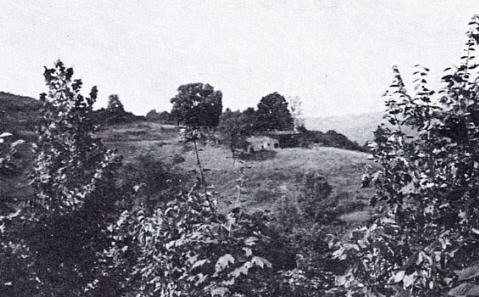
Site Of New Vrindaban, West Virginia
In September, 1965, A.C. Bhaktivedanta Swami a holy man in the renounced order of life landed in New York and introduced the Hare Krishna movement to the West. The movement is based on the chanting of the holy names of God: HARE KRISHNA, HARE KRISHNA, KRISHNA KRISHNA, HARE HARE/HARE RAMA, HARE RAMA, RAMA RAMA, HARE HARE. It has from time to time known great popularity in India, and now the Swami has set out to spread its influence in America. By July, 1966 Swamiji had already attracted enough young disciples to form the International Society for Krishna Consciousness. located in the East Village at 26 Second Avenue. In the religious corporation papers, it is noted that one of the main purposes of the society in propagating Krishna Consciousness is “to develop the idea within the members and humanity at large, that each soul is part and parcel of the quality of Godhead (Krishna).” The present column, devoted to the activities of the various Krishna Consciousness temples is therefore named Parts & Parcels in keeping with the Society’s mission.
New Hare Krishna centers are constantly being opened in order to fulfill Lord Chaitanya’s prophecy that Hare Krishna will someday be sung in every village and town throughout the world. Our latest center is called New Vrindaban, and is considerably more ambitious than any of our past endeavors. Located outside the Appalachian mountain town of Moundsville, 10 miles south of Wheeling, West Virginia, its purpose is “to serve as a holy place of transcendental pastimes, dedicated to Krishna, the Personality of Godhead.” New Vrindaban consists of 133 acres of land, including a stream with a waterfall and bathing ghats, woods, fields, and pasturage; and a knoll called “Goverdan Hill.” Only a house and a barn stand there now, but plans for the future are evolving quickly. As with all centers of Krishna Consciousness, this one is not located in the material world, but is spiritual by virtue of the work done there in devotion to God. Vrindaban in India is where Lord Krishna displayed His childhood pastimes as a cowherd boy, and one special feature of New Vrindaban is cow protection. Because of the great endeavor to build a spiritual city in the wilderness, with the dynamic determination to create a new and perfect human society, New Vrindaban will not be like the numerous country club ashrams popular with Yoga groups nowadays. Hayagriva Das Brahmachary, co-founder of the project, invites anyone interested to communicate with him c/o the Hare Krishna Temple at 26 Second Avenue in New York
Nayana Bhiram Das Brahmachary
Bhakti Bringa Govinda Swami Mantra Dubai 2010 English version
→ Gouranga TV - The Hare Krishna video collection
Bhakti Bringa Govinda Swami Mantra Dubai 2010 English version
Cooking classes
→ The Loft Yoga Lounge Auckland
Indian Festival Menu This Friday 19th July, is the next vegan/vegetarian cooking class with Acyuta bhava and Kasi priya and here is the delicious mouthing watering menu: Lemon Basmati Rice Rajma Curry Aloo Patra (spiced potato swirls) with fresh raisin chutney Vadai (savory lentil donuts) with coconut & coriander chutney North Indian Salad Chai Spiced [...]
The post Cooking classes appeared first on The Loft Yoga Lounge Auckland.
The Process Of Improving Habits PT.1
→ Japa Group
From Process Of Improving Habits
By Mahanidhi Swami
The Process Of Improving Habits PT.1
→ Japa Group
From Process Of Improving Habits
By Mahanidhi Swami
Daily Class – Aniruddha Prabhu
→ ISKCON Melbourne, AU
ISKCON Silicon Valley Temple Opening Part 2, July 6, San Jose
Giriraj Swami
 “Mukunda and his wife, Janaki, were actually planning to go to India. It occurred to Mukunda that maybe he should ask the Swami whether or not there was something he could do for him before he went. The answer was, ‘Since you are going to the West coast, why don’t you see if you can open another center.’ That wasn’t exactly what Mukunda had in mind, but he accepted the desire and instructions of Srila Prabhupada. So, he came to collect my husband and me, who at that time, as members of the hippy tradition, were not married but were living together on the top of a mountain in Oregon. We were employed by the federal government to look out for fires. The only fire we were not thinking of was the fire of devotional service. So, they stopped and asked if we would like to join them to open a temple. And I, in my infinite wisdom, asked him, ‘What is a temple?’ And he truthfully answered, ‘It is a storefront painted white.’ “ — Malati dasi
“Mukunda and his wife, Janaki, were actually planning to go to India. It occurred to Mukunda that maybe he should ask the Swami whether or not there was something he could do for him before he went. The answer was, ‘Since you are going to the West coast, why don’t you see if you can open another center.’ That wasn’t exactly what Mukunda had in mind, but he accepted the desire and instructions of Srila Prabhupada. So, he came to collect my husband and me, who at that time, as members of the hippy tradition, were not married but were living together on the top of a mountain in Oregon. We were employed by the federal government to look out for fires. The only fire we were not thinking of was the fire of devotional service. So, they stopped and asked if we would like to join them to open a temple. And I, in my infinite wisdom, asked him, ‘What is a temple?’ And he truthfully answered, ‘It is a storefront painted white.’ “ — Malati dasi
———————————————————————————————————








————————————————————————————————————————
Prabhupada Letters :: Anthology 2013-07-13 14:02:00 →
Prabhupada Letters :: 1947-64
Today’s Rathayatra in Budapest and why I am not there
→ SivaramaSwami.com
Jhulan Yatra Festival
→ ISKCON Melbourne, AU
 In Vrindavana during the springtime Holi festival Krishna performed this festival. It is the perfect object of meditation for those desiring a taste of devotion.
In Vrindavana during the springtime Holi festival Krishna performed this festival. It is the perfect object of meditation for those desiring a taste of devotion. You can personally swing the Lords from Saturday August the 17th till Wednesday August the 21st at 7pm. nightly.
We hope you will join us.
The Lord pulled along by his devotees
→ Mayapur.com
Please view the following gallery: Ratha Yatra Procession ne of the major festivals in Sri Mayapur’s busy calendar is surely Jagannath Ratha Yatra – A “Festival of the Heart”. The Lord of the Universe comes out of His temple to give His audience to one and all. The possibility of rain didn’t prove to be [...]
The post The Lord pulled along by his devotees appeared first on Mayapur.com.
Before Lord Caitanya’s Advent
→ HH Bhakti Caitanya Swami
Ratha Yatra Gallery
→ Mayapur.com
The post Ratha Yatra Gallery appeared first on Mayapur.com.
Gita Nagari Weekly Newsletter – July 4th, 2013
→ New Vrindaban Brijabasi Spirit
Click here to read the July 4th, 2013 newsletter from our sister community, the Gita Nagari Farm, in Port Royal PA.
Please visit and “like” the Gita Nagari Farm Facebook Page!
2013 07 04 Srimad Bhagavatam 10 22 01 Krishna tricks you to Surrender to him Candramauli Swami
→ Gouranga TV - The Hare Krishna video collection
2013 07 04 Srimad Bhagavatam 10 22 01 Krishna tricks you to Surrender to him Candramauli Swami
July 13th, 2013 – Darshan
→ Mayapur.com
The post July 13th, 2013 – Darshan appeared first on Mayapur.com.
Thursday, July 11th, 2013
→ The Walking Monk
Niagara Falls, Ontario
Bhakti Chaitanya Swami and I trekked along the Great Gorge. He liked it, it’s quite impressive. We even took to the aero car, a moving suspension unit that ski lifts you over a whirlpool of water. Who says that a monk can’t be a tourist and have some fun?
In all frankness we are far from being hermits. Our time together provided the opportunity to gain each other’s association. The exposure to the public is also good. Bhakti Chaitanya and I are both world travelers, although we travel in different directions and end up in different places. Generally we are always with people, formally, for meetings, and less so at festivals. Downtime is necessary, he just came from Siberia.
We compared notes. He said ticks are a big problem over there in Siberia. Many people die contracting fever from them. Also, Russian mosquitoes are huge and aggressive he said. He never heard of our vicious black flies that we have in Canada. The main principle is that there are many little vampires about in both lands in the raw of Siberia and Canada.
What about comparing the people? It seems that wherever there has been a communist regime, people are left with a curious mind, whereas capitalistic folks have become over stimulated. I leave it to you, the readers, to figure out who is who in this regards.
6 KM
Thursday, July 11th, 2013
→ The Walking Monk
Niagara Falls, Ontario
Bhakti Chaitanya Swami and I trekked along the Great Gorge. He liked it, it’s quite impressive. We even took to the aero car, a moving suspension unit that ski lifts you over a whirlpool of water. Who says that a monk can’t be a tourist and have some fun?
In all frankness we are far from being hermits. Our time together provided the opportunity to gain each other’s association. The exposure to the public is also good. Bhakti Chaitanya and I are both world travelers, although we travel in different directions and end up in different places. Generally we are always with people, formally, for meetings, and less so at festivals. Downtime is necessary, he just came from Siberia.
We compared notes. He said ticks are a big problem over there in Siberia. Many people die contracting fever from them. Also, Russian mosquitoes are huge and aggressive he said. He never heard of our vicious black flies that we have in Canada. The main principle is that there are many little vampires about in both lands in the raw of Siberia and Canada.
What about comparing the people? It seems that wherever there has been a communist regime, people are left with a curious mind, whereas capitalistic folks have become over stimulated. I leave it to you, the readers, to figure out who is who in this regards.
6 KM
Put Your Heart Into It
→ Japa Group
Today I was listening to a class of a devotee from Vrindavan and he said some stories of how some devotees are so attached to the Holy names that they can't stop chanting for a minute - I thought it was a very good feeling to have because when we feel attached there is no need to think of anything else - our mind won't wander anymore and we will be able to give 100% to the Lord through chanting.
This is an amazing goal to achieve and it can happen to anyone, even the ones that are in the beginning of devotional service. The main thing is to hear the mantra and the Lord Himself who is the His holy names come and join us & enter in our hearts and we can feel the eternal relationship of service with Him.
I pray so I can reach this level of service and I can chant with my whole heart absorbed in the process.
Hoping you all have a nice weekend of chanting and service.
your servant,
Aruna devi



